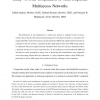Free Online Productivity Tools
i2Speak
i2Symbol
i2OCR
iTex2Img
iWeb2Print
iWeb2Shot
i2Type
iPdf2Split
iPdf2Merge
i2Bopomofo
i2Arabic
i2Style
i2Image
i2PDF
iLatex2Rtf
Sci2ools
CORR
2008
Springer
2008
Springer
Relay vs. User Cooperation in Time-Duplexed Multiaccess Networks
The performance of user-cooperation in a multi-access network is compared to that of using a wireless relay. Using the total transmit and processing power consumed at all nodes as a cost metric, the outage probabilities achieved by dynamic decode-and-forward (DDF) and amplify-and-forward (AF) are compared for the two networks. A geometry-inclusive high signal-to-noise ratio (SNR) outage analysis in conjunction with area-averaged numerical simulations shows that user and relay cooperation achieve a maximum diversity of K and 2 respectively for a K-user multiaccess network under both DDF and AF. However, when accounting for energy costs of processing and communication, relay cooperation can be more energy efficient than user cooperation, i.e., relay cooperation achieves coding (SNR) gains, particularly in the low SNR regime, that override the diversity advantage of user cooperaton.
| Added | 09 Dec 2010 |
| Updated | 09 Dec 2010 |
| Type | Journal |
| Year | 2008 |
| Where | CORR |
| Authors | Lalitha Sankar, Gerhard Kramer, Narayan B. Mandayam |
Comments (0)

